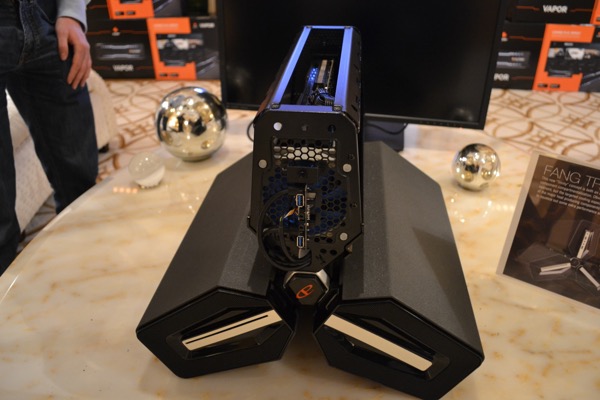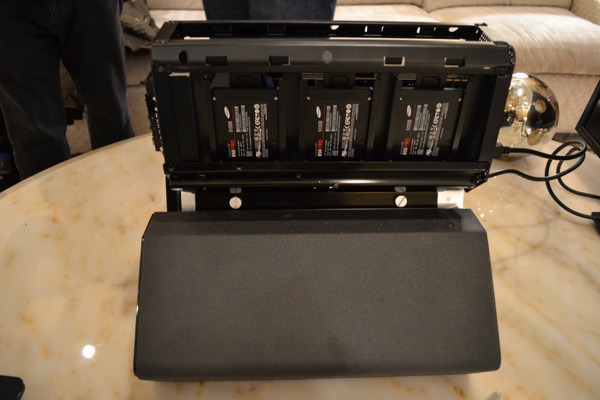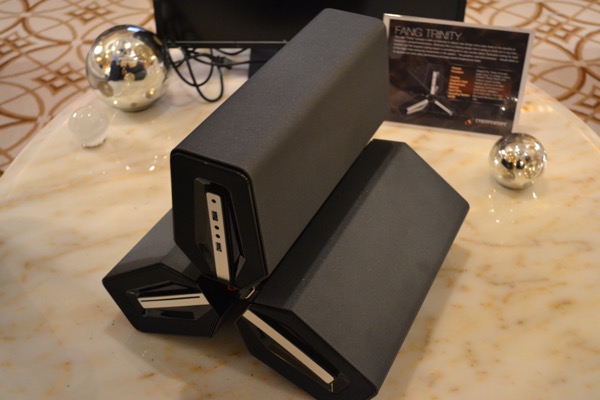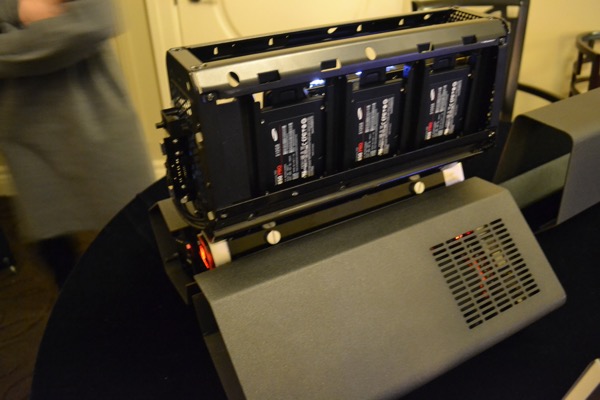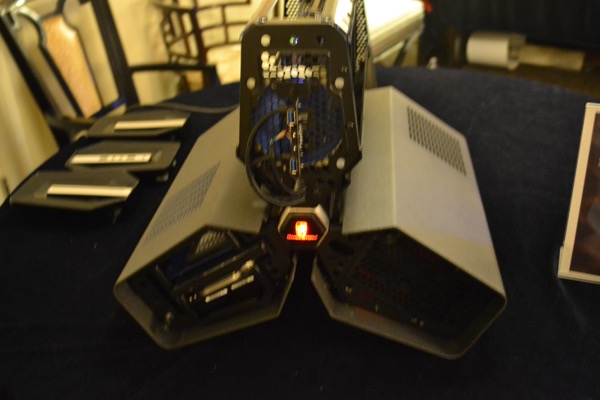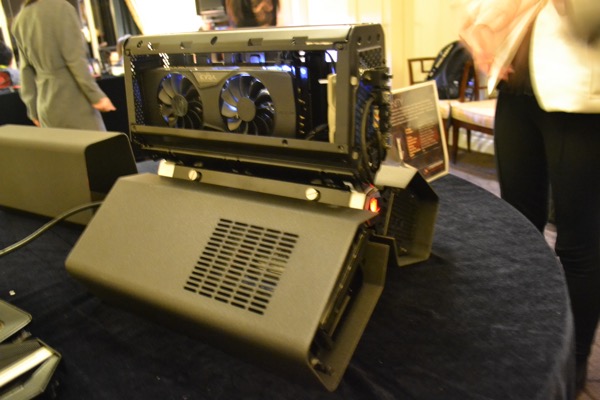Deepcool Shows Off Unique Star-Shaped Tristellar Case With CyberPowerPC Trinity Prototype
At CES 2015, Deepcool (a Chinese manufacturer of cases, cooling components and PSUs) launched a new chassis called the Tristellar, and it features a rather unique design that is truly unlike anything we've seen before.
The chassis is split into three separate compartments, and contrary to what you might expect, it's actually a quite logical arrangement. One of the compartments can house a Mini-ITX motherboard and a 120 mm liquid cooler, while another could contain the power supply, a pair of 3.5-inch hard drives and a slim slot-loading optical drive. Meanwhile, the third compartment can support a full-size dual-slot graphics card and three 2.5-inch hard drives.
All of the cabling is routed through the center piece which holds all three compartments together. What's more, each section also has its own air-flow loop, ensuring that none of the heat from the CPU or motherboard will interfere with the graphics card, or vice versa.
However, the Tristellar isn't the most practical case we've ever seen. It should prove quite difficult to build in, and servicing it is sure to be a pain, as it's built out of heavier-gauge steel than we're used to seeing — about 50 pounds with an assembled system inside — and the three compartment covers are also difficult to remove.
But the idea behind this case isn't practicality; it's meant to be a piece of art, and to show off what Deepcool is capable of designing.
Despite using steel instead of aluminum to save on the build cost, the Tristellar will nevertheless be rather pricy. Deepcool hasn't settled on final pricing yet, but the company has indicated that it won't be cheap, possibly costing upwards of $400 or even $500.
Additionally, system builder CyberPowerPC is using the Tristellar chassis to build a system it calls the Trinity. It was built as a showy prototype, and the company told us that the case it had on display was one of only two in existence. Because the internal hardware configuration wasn't yet finalized, the company also couldn't give an indication on pricing. It did, however, value the case at about $369 by itself. Let's try not to think too hard about how much all the tasty components inside the Trinity might add up to.
Get Tom's Hardware's best news and in-depth reviews, straight to your inbox.
One thing we'd like to point out about a case like this is that companies don't build them to make money. They cost too much to design and to build, and they never sell in mass quantities. What they do accomplish, however, is draw attention to a brand. Knowing that a company is capable of designing a statement case does say something about what it does in more sensible spaces. It doesn't say everything, but it certainly says something.
Follow Niels Broekhuijsen @NBroekhuijsen. Follow us @tomshardware, on Facebook and on Google+.
Niels Broekhuijsen is a Contributing Writer for Tom's Hardware US. He reviews cases, water cooling and pc builds.
-
mordac35 It reminds me of something out of Star Wars. It might actually look better if it were standing on end. Too bad they didn't design it that way.Reply -
codyleemanofaction ReplyIt might actually look better if it were standing on end. Too bad they didn't design it that way.
I think I like it in the current configuation for looks... but on end might have made for a better airflow, if they moved the vents of course.
Way more than I'd be willing to pay for it though. I understand where the pricing comes from, between low marketability, difficult construction and heavy components... it'll be a great niche product for gamers with money to blow. Like a Bentley... in my line of work it just doesn't make sense... but somebody somewhere thinks they're great.
-
f-14 ReplyIt reminds me of something out of Star Wars.
i tried looking it up for exactly what it was, i just remember that it was a space container for the x-wing vs tie fighter game. cygnus systems/space works keeps popping into mind and it's not. i just remember hiding behind them as the shape threw every one off at first glance in multi player games.
-
Vlad Rose 50LBS! YIKES! I don't see many geeks carrying that thing to many LAN parties. If they do, they may as well turn into muscle builders instead... lolReply -
turkey3_scratch Finally something new and innovative in the world of cases. We have been using boxes for too long now! Time for the Death Star!Reply
But seriously this looks like a great idea to me. I love the way the cables are handled through the center and how the 3 areas are for different components. I love the look, and who cares if its 50lbs, it's not like you hold your case when you use the computer, no, it sits on a shelf. -
codyleemanofaction For the price- each compartment should be sealed so that you can run a mineral oil cooling loop! That would be sexy.Reply -
Calvin Huang 50lbs with an assembled system inside isn't that heavy. A full tower usually weighs 20~30lbs by itself. Add in the video card, drives and motherboard, and you're getting close to 30~40lbs. A Mac Pro weighs on average 42.4lbs.Reply
And the difficulty of moving a full tower is usually the unwieldy size/shape. This seems compact enough to simply wrap a single arm around it. -
Mr Knight Looks like a pod racer front, from Star Wars Episode I. Personally not a fan. So regardless how much money I had it isn't worth it. Being reminded of Star Wars Episode I isn't a good thing is my eyes.Reply -
f-14 ReplyIt reminds me of something out of Star Wars.
i tried looking it up for exactly what it was, i just remember that it was a space container for the x-wing vs tie fighter game. cygnus systems/space works keeps popping into mind and it's not. i just remember hiding behind them as the shape threw every one off at first glance in multi player games.
i finally placed it/found it
Class-I cargo container
119,545PAGES ON
THIS WIKI Edit Talk0 Eras-legends30px-Era-reb
Class-I Cargo Container
Class-I cargo container
Production information
Manufacturer
Xizor Transport SystemsProduct line
Xizor cargo containersModel
Cargo containerClass
I
Technical specifications
Shielding
120 SBDHull
20 RUUsage
Era(s)
Rebellion eraAffiliation
Galactic EmpireRebel AllianceVarious private, commercial, and pirate interestsThe Class-I Cargo Container was a Y-shaped freight container manufactured by Xizor Transport Systems and designed to be carried by freighters. The container was used to store cargo during transit in both realspace and hyperspace. The Class-I cargo container was utilized to transport completed items.
http://starwars.wikia.com/wiki/Class-I_cargo_container -
f-14 ReplyIt reminds me of something out of Star Wars.
i tried looking it up for exactly what it was, i just remember that it was a space container for the x-wing vs tie fighter game. cygnus systems/space works keeps popping into mind and it's not. i just remember hiding behind them as the shape threw every one off at first glance in multi player games.
i finally placed it/found it
Class-I cargo container
119,545PAGES ON
THIS WIKI Edit Talk0 Eras-legends30px-Era-reb
Class-I Cargo Container
Class-I cargo container
Production information
Manufacturer
Xizor Transport SystemsProduct line
Xizor cargo containersModel
Cargo containerClass
I
Technical specifications
Shielding
120 SBDHull
20 RUUsage
Era(s)
Rebellion eraAffiliation
Galactic EmpireRebel AllianceVarious private, commercial, and pirate interestsThe Class-I Cargo Container was a Y-shaped freight container manufactured by Xizor Transport Systems and designed to be carried by freighters. The container was used to store cargo during transit in both realspace and hyperspace. The Class-I cargo container was utilized to transport completed items.
http://starwars.wikia.com/wiki/Class-I_cargo_container
